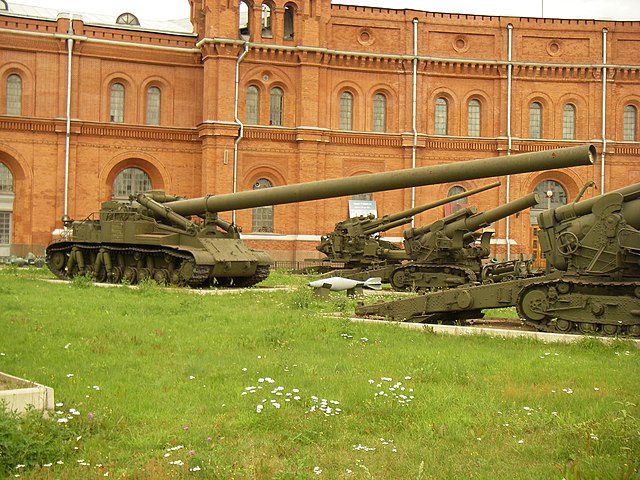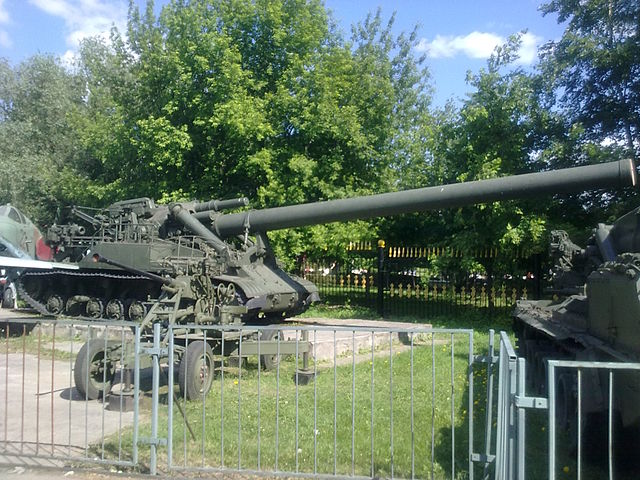The Soviet "Atomic Gun"
The 2A3 originated as a fitting answer to US newly created "Pentomic Division". This tactical doctrine emphasized widespread tactical use of nuclear weapons on the battlefield, and this included nuclear artillery. The US M65 cannon (1952) was developed for such occasion. It was quickly deployed in Germany, in 1953. The Soviet Union could stay inactive and quickstarted its own program with high priority in order to counter it by all means necessary, and develop its own 16 inches self-propelled howitzer (406mm), a caliber deemed sufficient to cram inside a this special shell very small nuclear warhead. The program was codenamed 'Objekt 271'. It was paraded on the red square and publicly revealed in 1957, although ready in 1956, doing its propaganda effect. But apart some testings, the only four built remained in reserve until Nikita Khrushchev's reforms emphasis the use of missile instead and the program was shelved. These vehicles are now exhibited in various places since the 1960s, like the one on static display at the Central Armed Forces Museum in Moscow today.
The Other "atomic gun", super-heavy artilley system: 2B1 "Oka"
Development
According to the decree of the Council of Ministers of the USSR, dated November 18, 1955, work began on the 2B1 "Oka" self-propelled mortar and 2A3 "Condenser-2P" self-propelled gun at the same time. The main purpose of the latter was the long-range ability to destroy large industrial and military facilities of the enemy. So both conventional HE and nuclear shells were developed to be used. The elf-propelled artillery vehicle, the loading and guidance mechanisms were all developed under the direction of Ivanov, at TsKB-34.The Grabin Design Bureau the prototype artillery system in 1955. Called 'Objekt 271', the chassis was developed by the Kotlin Design Bureau in Leningrad. The latter was completed soon thereafter. The unified system received designation 2A3. It was fitted-out and completed in 1956, at the Kirov Works in Leningrad. Only four prototypes were ordered.
In 1957, the first prototypes were assembled at the Leningrad Kirov plant. They were sent to the shooting range for first evaluations, and further tests were carried out later at the Central Artillery Range near Leningrad. As a result of these, a number of critical defects were identified:
-Disruption of the gearbox mountings
-Rollback of the combat vehicle by several meters
-Destruction of fine tunes systems
-Damage to firing simulators of nuclear weapons.
It was clear that the powerful blast was enough to destroy, disjoint or damage onboard equipment, as well as an excessive recoil. Work to eliminate these defects and improve the design were carried out until 1960, so well after the prototyes were paraded on the resr square. They were not operational back then. The rededisn was radical and asked for the suspension of all sensible equipments, separated from the gun cradle, and improved recooild system possibly with a tailored muzzle brake, etc. However in 1960, the whole program was abruplty stopped by a decree of the Council of Ministers of the USSR, by order of Nikita Khrushchev...
Design of the 2A3
406 mm Howitzer
It was a derivative of WW2 naval guns, and its precise caliber was 406.4 mm. It was called SM-54 (as developed and approved in 1954). This grooved barrel gun could fire at a range up to 25.6, the minimum to avoid nuclear fallout from the tactical explosion. The gun could also fire standard shells, with a utility 570 kgs warhead loaded with torpex or equivalent.The SM-54 cannon was placed on a cradle using special hydraulic drive (two arms fitted on the forward glacis plate) for elevation but traverse was inexistant. For this, the entire vehicle needed to be pointed in the right direction, taking a strain on the chassis and wheeltrain. In order to improve accuracy in that case, engineered developed a turning mechanism associated with a special electric motor. There were two walways on either sides of the cradle and a rload apparatus aft, with a crane and laying bed. It seems that no spades were provided, explaining the high recoil. There was a fully enclosed cabin for the main firing console on the right side.
Chassis
The chassis and powerplant were developed on the basis of components and assemblies of the T-10M heavy tank. According to the GBTU index it was named "Obyekt 271". It comprised the same drivetrain with stamped roadwheels, individual torsion bars, seven return rollers per side, the main difference being the extra roadwheel pair. Also there were two drive sprockets, one forward and one aft the aft one being use for propulsion, for forward one for tension.The In-12-6B diesel supercharged Engine power was 750 hp or 552 kW at 2100 turn/min. Its range was 200 km on road, at cruiser speed. power to weight ratio was massive, 11.7 tons. Ground pressure is unknown.
The gun crew was directed by the commander which operated the gun using the sights TPV-51, the "Ugol" system and S-71-5, or ZIS-3 vehicle for relay. There was no space onboard for shells, which were carried by support and supply vehicles.
Public reveal and active life
Western observers first saw the 2A3 Kondensator during the 1957 May parade on Red Square. Initially observers thought that this weapon system was just a mockup created for deterrent effect. It was learned later that the vehicles were "operational" although it was never the case. Instead, the 2A3 Kondensator had an exceptionally short service life. Following a period of extensive testing, all four vehicles were assigned to the Artillery High Command reserve. They remained in "service" until the military reforms of Nikita Khrushchev. When enacted, preferring more accurate and modern missile systems over super-heavy artillery inherited from the Stalinist ear, as well asheavy tanks, the program was shelved definitely and all four Kondensator howitzers were retired in about 1965.Read More
About the 2A3About the 2B1 "Oka"
On FAS.org
On russianwarrior.com
On globalsecurity.org
On valka.cz
М. В. Павлов, И. В. Павлов. Отечественные бронированные машины 1945—1965 гг. // Техника и вооружение: вчера, сегодня, завтра. — Москва: Техинформ, 2009. — № 8. — С. 56.
(рус.) // Карпенко А. В. Бастион : Военно-технический сборник. — Санкт-Петербург. — Вып. Часть 3. Тяжёлые самоходные артиллерийские установки, № 8
2A3 Kondensator specifications | |
| Dimensions | 20 x 3.08 x 5.75m (65'7'' x 10'1'' x 18'1'' ft) |
| Total weight, battle ready | 64 tons |
| Crew | 8 (driver, commander, 6 guns crew) |
| Propulsion | In-12-6B diesel supercharged 552 kW (751 hp) |
| Suspension | Torsion bars |
| Speed (road) | 65 km/h (40 mph) |
| Range | 200 km (90 mi) |
| Armament | 406 mm (16 in) howitzer, 570 kg, 25.6 km |
| Armor | 10 mm frontal arc (0.39 in) |
| Total production | 4 in 1956 |
Gallery

2A3 Kondensator profile.




Cold War Tanks


































Cold war tanks posters

Cold War Main Battle Tanks

Cold War Soviet Army

